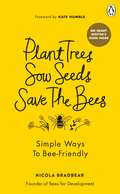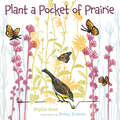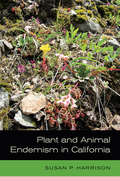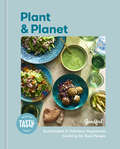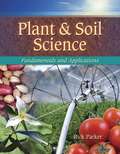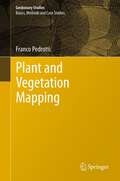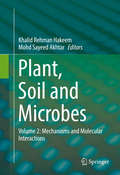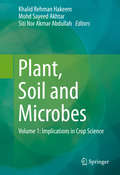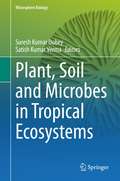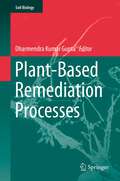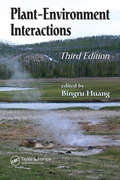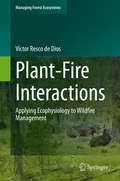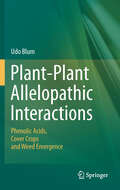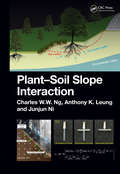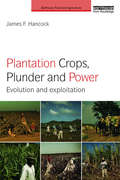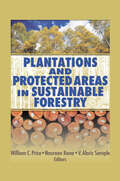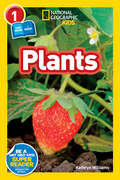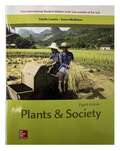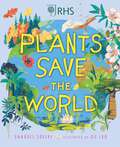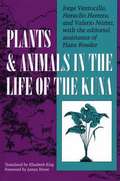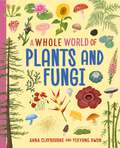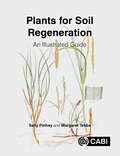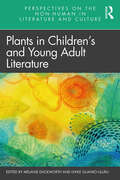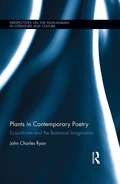- Table View
- List View
Plant Trees, Sow Seeds, Save The Bees: Simple ways to bee-friendly
by Nicola BradbearDiscover the wonder of bees (and other stripey insects) and how to help them survive. In this little book of bees, wasps, hoverflies and more, discover the easy ways to make your gardens, window boxes and pots insect havens. Rewild your garden with plants for bees and honeybees - simple acts of kindness to save the planet. Expert Nicola Bradbear, from Bees for Development charity, shows you how and why it's so important.There are lots of fun things you can do to make a big difference.With every book sold, proceeds will be donated to Bees for Development (www.beesfordevelopment.org)
Plant a Pocket of Prairie
by Phyllis RootAuthor Phyllis Root and illustrator Betsy Bowen last explored the vast, boggy peatlands of northern Minnesota in their book Big Belching Bog. Now, in Plant a Pocket of Prairie, Root and Bowen take young readers on a trip to another of Minnesota&’s important ecosystems: the prairie. Once covering almost 40 percent of the United States, native prairie is today one of the most endangered ecosystems in the world. Plant a Pocket of Prairie teaches children how changes in one part of the system affect every other part: when prairie plants are destroyed, the animals who eat those plants and live on or around them are harmed as well. Root shows what happens when we work to restore the prairies, encouraging readers to &“plant a pocket of prairie&” in their own backyards. By growing native prairie plants, children can help re-create food and habitat for the many birds, butterflies, and other animals that depend on them. &“Plant cup plants,&” Root suggests. &“A thirsty chickadee might come to drink from a tiny leaf pool. Plant goldenrod. A Great Plains toad might flick its tongue at goldenrod soldier beetles.&” An easy explanation of the history of the prairie, its endangered status, and how to go about growing prairie plants follows, as well as brief descriptions of all the plants and animals mentioned in the story. With Betsy Bowen&’s beautiful, airy illustrations capturing the feel of an open prairie and all its inhabitants, readers of all ages will be inspired to start planting seeds and watching for the many fascinating animals their plants attract. What a marvelous transformation could take place if we all planted a pocket of prairie!
Plant and Animal Endemism in California
by Susan P. HarrisonCalifornia is globally renowned for its biological diversity, including its wealth of unique, or endemic, species. Many reasons have been cited to explain this abundance: the complex geology and topography of its landscape, the special powers of its Mediterranean-type climate, and the historic and modern barriers to the wider dispersal of its flora and fauna. Plant and Animal Endemism in California compiles and synthesizes a wealth of data on this singular subject, providing new and updated lists of native species, comparing patterns and causes of both plant and animal endemism, and interrogating the classic explanations proposed for the state's special significance in light of new molecular evidence. Susan Harrison also offers a summary of the innovative tools that have been developed and used in California to conserve and protect this stunning and imperiled diversity.
Plant and Planet: Sustainable and Delicious Vegetarian Cooking for Real People
by GoodfulSimple steps can make an impact on our planet. From BuzzFeed&’s Goodful, these 75 plant-based recipes plus plenty of low-waste strategies will guide you to a sustainable life you can feel good about.Goodful offers approachable recipes, tips, and guides for everyday life. In Plant and Planet, discover seventy-five plant-based recipes for meal prep, everyday celebrations, and cooking with the seasons, from Zucchini Lasagna Boats and Black Bean & Walnut Quesadillas to Caramelized Banana & Orange Parfaits, along with tons of ways to stock your kitchen, grow your own ingredients, turn your scraps into amazing treats, and more. Beautifully photographed, this cookbook is super practical and impactful, with surprising and easy ways to reduce environmental impact, shopping guides and meal plans, information about repurposing food waste, plus a guide to growing your own ingredients. You will learn how to:• Approach cooking from a seasonal perspective• Minimize packaging while maximizing flavor• Clear out your fridge and freezer to make comforting soups, salads, and other dishesFeaturing contributions from experts DeVonn Francis, Lorena Ramirez, Lauren Singer, Nadiya Hussain, Kelis Rogers, David Zilber, and Ben Flanner, Plant and Planet is filled with tips and quick hits of information about the environmental impact of these recipes--all to deliver a low-stress, high-impact path to a low-waste kitchen.
Plant and Soil Science: Fundamentals and Applications
by Rick ParkerThis book combines the basic knowledge of plant and soil science, in an easy to read and teach format, and provides practical real world application for information learned. Organized into twenty-eight chapters, each chapter features learning objectives, key terms, tables, charts, illustrations and color photographs to aid the learning and teaching process.
Plant and Vegetation Mapping
by Franco PedrottiThe book is concerned principally with geobotanical mapping. Geobotany is a broad science that deals with the study of species and of vegetation communities in relation to the environment; it includes other, perhaps more familiar sciences, such as plant geography, plant ecology, and chorology, and phytosociology (plant sociology). Geobotanical cartography is a field of thematic cartography that deals with the interpretation and representation, in the form of maps, of those spatial and temporal phenomena that pertain to flora, vegetation, vegetated landscapes, vegetation zones, and phytogeographical units. The production of a geobotanical map represents the last stage in a cognitive process that begins with observations in the field and continues with the collection of sample data, interpretation of the phenomena observed, and their appropriate cartographic representation; geobotanical cartography is closely tied to the concepts and scope of geobotany in general
Plant, Soil and Microbes
by Khalid Rehman Hakeem Mohd Sayeed AkhtarThe interactions between the plant, soil, and microbes are very complex in nature and may be antagonistic, mutualistic, or synergistic, depending upon the types of microorganisms and their association with the plant and soil. The multi-trophictactics are involved in these types of interactions to nourish the plants in various habitats and conditions. Understanding the mechanisms of these interactions is highly desired to utilize the knowledge in such an eco-friendly and sustainable way, which may not only resolve the upcoming food security issues but also make the environment green by reducing the chemical inputs. Plant, Soil and Microbes: Mechanisms and Molecular Interactions, along with the recently published Plant, Soil and Microbes: Implications in Crop Science, provide detailed accounts of the exquisite and delicate balance between the three critical components of agronomy. Specifically, these two titles focus on the basis of nutrient exchange between the microorganisms and the host plants, the mechanism of disease protection and the recent molecular details emerged from studying this multitropic interaction. Together they provide a solid foundation for the students, teachers, and researchers interested in soil microbiology, plant pathology, ecology and agronomy.
Plant, Soil and Microbes
by Khalid Rehman Hakeem Mohd Sayeed Akhtar Siti Nor Akmar AbdullahThe interactions between the plant, soil and microbes are complex in nature. Events may be antagonistic, mutualistic or synergistic, depending upon the types of microorganisms and their association with the plant and soil in question. Multi-trophic tactics can therefore be employed to nourish plants in various habitats and growth conditions. Understanding the mechanisms of these interactions is thus highly desired in order to utilize the knowledge in an ecofriendly and sustainable way. This holistic approach to crop improvement may not only resolve the upcoming food security issues, but also make the environment greener by reducing the chemical inputs. Plant, soil and microbe, Volume 1: Implications in Crop Science, along with the forthcoming Volume 2: Mechanisms and Molecular Interactions, provide detailed accounts of the exquisite and delicate balance between the three critical components of agronomy. Specifically, these two titles focus on the basis of nutrient exchange between the microorganisms and the host plants, the mechanism of disease protection and the recent molecular details emerged from studying this multi-tropic interaction. Together they aim to provide a solid foundation for the students, teachers, and researchers interested in soil microbiology, plant pathology, ecology and agronomy.
Plant, Soil and Microbes in Tropical Ecosystems (Rhizosphere Biology)
by Satish Kumar Verma Suresh Kumar DubeyThis book describes the multitude of interactions between plant, soil, and micro-organisms. It emphasizes on how growth and development in plants, starting from seed germination, is heavily influenced by the soil type. It describes the interactions established by plants with soil and inhabitant microbial community. The chapters describe how plants selectively promote certain microorganisms in the rhizospheric ecozone to derive multifarious benefits such as nutrient acquisition and protection from diseases. The diversity of these rhizospheric microbes and their interactions with plants largely depend on plant genotype, soils attributes, and several abiotic and biotic factors. Most of the studies concerned with plant–microbe interaction are focused on temperate regions, even though the tropical ecosystems are more diverse and need more attention. Therefore, it is crucial to understand how soil type and climatic conditions influence the plant–soil–microbes interaction in the tropics. Considering the significance of the subject, the present volume is designed to cover the most relevant aspects of rhizospheric microbial interactions in tropical ecosystems. Chapters include aspects related to the diversity of rhizospheric microbes, as well as modern tools and techniques to assess the rhizospheric microbiomes and their functional roles. The book also covers applications of rhizospheric microbes and evaluation of prospects improving agricultural practice and productivity through the use of microbiome technologies. This book will be extremely interesting to microbiologists, plant biologists, and ecologists.
Plant-Based Remediation Processes
by Dharmendra Kumar GuptaPhytoremediation is an emerging technology that employs higher plants for the clean-up of contaminated environments. Basic and applied research have unequivocally demonstrated that selected plant species possess the genetic potential to accumulate, degrade, metabolize and immobilize a wide range of contaminants. The main focus of this volume is on the recent advances of technologies using green plants for remediation of various metals and metalloids. Topics include biomonitoring of heavy metal pollution, amendments of higher uptake of toxic metals, transport of heavy metals in plants, and toxicity mechanisms. Further chapters discuss agro-technological methods for minimizing pollution while improving soil quality, transgenic approaches to heavy metal remediation and present protocols for metal remediation via in vitro root cultures.
Plant-Environment Interactions
by Bingru HuangWith contributions from experts in various specialties, Plant-Environment Interactions discusses recent advances in cellular and molecular regulation of stress tolerance. This third edition reviews new research in stress signal perception, cellular mechanisms, and genetic manipulation of stress tolerance for each individual stress. It addresses how to evaluate the level of plant tolerance to stress as well as how to link mechanisms identified through analysis of plant-environment interaction to producing stress-tolerant germplasm through biotechnology and traditional breeding. It also examines environmental stresses limiting plant productivity in agriculture, horticulture, and forestry.
Plant-Fire Interactions: Applying Ecophysiology to Wildfire Management (Managing Forest Ecosystems #36)
by Víctor Resco de DiosThis book provides a unique exploration of the inter-relationships between the science of plant environmental responses and the understanding and management of forest fires. It bridges the gap between plant ecologists, interested in the functional and evolutionary consequences of fire in ecosystems, with foresters and fire managers, interested in effectively reducing fire hazard and damage.This innovation in this study lies in its focus on the physiological responses of plants that are of relevance for predicting forest fire risk, behaviour and management. It covers the evolutionary trade-offs in the resistance of plants to fire and drought, and its implications for predicting fuel moisture and fire risk; the importance of floristics and plant traits, in interaction with landform and atmospheric conditions, to successfully predict fire behaviour, and provides recommendations for pre- and post- fire management, in relation with the functional composition of the community. The book will be particularly focused on examples from Mediterranean environments, but the underlying principles will be of broader utility.
Plant-Plant Allelopathic Interactions: Phenolic Acids, Cover Crops and Weed Emergence
by Udo BlumIn an effort to implement conservation measures farmers have used a variety of production methods, including the use of reduced or zero tillage and cover crops. One benefit of these production methods has been early season weed control. The literature suggests that a variety of mechanisms may be involved, among them the allelopathic effects of phenolic acids. This retrospective analysis addresses the following: How likely are phenolic acid concentrations and environmental conditions in wheat no-till cropping systems for the inhibition of annual broadleaf weed emergence? and Do phenolic acids have a dominant role or are they just one component of a larger promoter/modifier/inhibitor complex? The book covers allelopathic plant-plant interactions, laboratory and field experiments, and future research. It uses a journal format, provides justifications for procedures used, if-then hypotheses, and cons and pros so that readers can reach their own conclusions.
Plant-Soil Slope Interaction
by Charles Wang Ng Anthony Leung Junjun NiThis inter-disciplinary book provides the latest advanced knowledge of plant effects on vegetated soil properties such as water retention capability, water permeability function, shear strength, slope hydrology, movements and failure mechanisms, and applies this knowledge to the solution of slope stability problems. It is the first book to cover in detail not only the mechanical effects of root reinforcement but more importantly the hydrological effects of plant transpiration on soil suction, soil shear strength, and water permeability. The book also offers a fundamental understanding of soil-plant-water interaction. Analytical equations are provided for predicting the combined hydrological and mechanical effects of plant roots on slope stability. A novel method is also given for simulating transpiration-induced suction in a geotechnical centrifuge. Application of this method to the study of the failure mechanisms of vegetated slopes reinforced by roots with different architectures is discussed. This book is essential reading for senior undergraduate and postgraduate students as well as researchers in civil engineering, geo-environmental engineering, plant ecology, agricultural science, hydrology and water resources. It also provides advanced knowledge for civil engineers seeking "green" engineering solutions to combat the negative impact of climate change on the long-term engineering sustainability of infrastructure slopes. Professionals other than civil engineers, such as ecologists, agriculturists, botanists, environmentalists, and hydrologists, would also find the book relevant and useful.
Plantation Crops, Plunder and Power: Evolution and exploitation (Earthscan Food and Agriculture)
by James F. HancockOver the last five centuries, plantation crops have represented the best and worst of industrialized agriculture – "best" through their agronomic productivity and global commercial success, and "worst" as examples of exploitative colonialism, conflict and ill-treatment of workers. This book traces the social, political and evolutionary history of seven major plantation crops – sugarcane, banana, cotton, tea, tobacco, coffee and rubber. It describes how all of these were domesticated in antiquity and grown by small landowners for thousands of years before European traders and colonists sought to make a profit out of them. The author relates how their development and spread were closely associated with government expansionist policies. They stimulated the exploration of far off lands, were the focus of major conflicts and led to the enslavement of both native and displaced peoples. From the southern United States, Latin America and the Caribbean, to Asia and Africa, plantation crops turned social structures upside down leading to revolution and government change. The economies of whole countries became tied to the profits of these plantations, leading to internal power struggles to control the burgeoning wealth. Open warfare routinely broke out between the more powerful countries and factions for trade dominance. This book shows that from the early 1500s to today, at least one of the plantation crops was always at the center of world politics, and that this still continues today, for example with the development of oil palm plantations in Southeast Asia. Written in an accessible style, it is fascinating supplementary reading for students of agricultural, environmental and colonial history.
Plantation Worlds
by Maan BaruaIn Plantation Worlds, Maan Barua interrogates debates on planetary transformations through the histories and ecologies of plantations. Drawing on long-term research spanning fifteen years, Barua presents a unique ethnography attentive to the lives of both people and elephants amid tea plantations in the Indian state of Assam. In the nineteenth and early twentieth centuries, nearly three million people were brought in to Assam’s plantations to work under conditions of indenture. Plantations dramatically altered the region’s landscape, plundered resources, and created fraught worlds for elephants and people. Their extractive logics and colonial legacies prevail as durations, forging the ambit of infrastructures, labor, habitability, and conservation in the present. And yet, as the perspectives of the Adivasi plantation worker community and lifeworlds of elephants show, possibilities for enacting a decolonial imaginary of landscape remain present amid immiseration. From the margins of the Global South, Barua offers an alternative grammar for articulating environmental change. In so doing, he prompts a rethinking of multispecies ecologies and how they are structured by colonialism and race.
Plantations and Protected Areas in Sustainable Forestry
by V. Alaric Sample William C. Price Naureen RanaUnderstand the social, economic, and environmental impacts of the development of forest plantationsand the conservation involvedControversy surrounds the question of how to best protect forests of high conservation value, while meeting the growing demands for wood and wood fiber-based products. Plantations and Protected Areas in Sustainable Forestry presents the views of a diverse group of conservationists and natural resource professionals who examine important social and economic as well as ecological aspects of the debate. The goal of sustainable forest management is kept at the forefront of the discussions, while alternative strategies to meet economic and social needs are explored in light of the need to conserve biological diversity and protect other important ecological services and environmental values in key forest areas. For developed nations, there is an ethical responsibility to consider sensible development as well as environmental conservation. Plantations and Protected Areas in Sustainable Forestry discusses many of the prominent issues that are raised when considering intensively managed forests (plantations) and/or strict protection of high conservation value forests (protected areas) in the United States and elsewhere. These issues include: the role of plantations and their management; forest management certification to ensure sustainability; job creation from plantations, the effects of intensive forest management on society and the environment; and the protection of biodiversity. This book provides a solid foundation on which to form a consensus that addresses the needs of economics and society as well as forest conservation.Topics in Plantations and Protected Areas in Sustainable Forestry include: the future of forest plantations forest management certification community benefits derived from intensively managed industrial roundwood plantations the extent to which intensive forest management practices on plantations prevent degradation of natural forests positive and negative impacts of plantations on environmental and social values alternative approaches for investment in wood production global policy perspectives on intensive forest production global strategies for biodiversity conservation Plantations and Protected Areas in Sustainable Forestry provides a diversity of perspectives on one of today’s most important developments in international forest policy and international trade in the forest sector. It is intended to contribute to better-informed decision-making, and is an important book for policymakers, forest resource management professionals, and business leaders working to develop practical and effective strategies for sustainable forest management.
Plants (Readers)
by Kathryn WilliamsAdult and child readers will learn all about plants together in this new Co-reader from National Geographic Kids. Find out how plants grow as well as the different parts of plants, seeds, and flowers.
Plants And Society
by Estelle Levetin Karen McMahonThis introductory, one quarter/one-semester text takes a multidisciplinary approach to studying the relationship between plants and people. The authors strive to stimulate interest in plant science and encourage students to further their studies in botany. Also, by exposing students to society's historical connection to plants, Levetin and McMahon hope to instill a greater appreciation for the botanical world. Plants and Society covers basic principles of botany with strong emphasis on the economic aspects and social implications of plants and fungi.
Plants Save the World
by Annabel SaveryProduced in partnership with the RHS, Plants Save the World shows how plants are going to help us to SAVE the world!From tiny seeds and weeds to massive trees, plants come in all different shapes, sizes and colours. They can be found all over the world. In fact, they're so common, we hardly notice them at all. But plants are the foundation of all life on Earth - without them, we cannot survive! They provide food and medicine, clean the air we breathe, provide habitats for animals, protect against disasters, such as flooding, and are used to make products that we use every day. But plants are threatened by humans and so this book shows you how you can help to save them, too!Supports the science curriculum in the study of plant life cycles, plant parts, food chains, ecosystems, deforestation and habitats.In the accompanying book, Bugs Save the World, you can discover why bugs are so important to the survival of our planet, too.
Plants and Animals in the Life of the Kuna
by Jorge Ventocilla Heraclio Herrera Valerio Núñez"The earth is the mother of all things"; thus begins this original and accessible book on how the Kuna of Panama relate to the natural world. An integrative project involving Kuna traditional leaders and trained scholars, and fully illustrated by a Kuna artist, this translation of Plantas y animales en la vida del pueblo Kuna focuses on Kuna plant and animal life, social life, and social change as a means of saving traditional ecological knowledge and "returning" it to the community. The authors hope to preserve the Kuna environment not only by reviving traditional technologies but also by educating the Kuna as to what needs protection. While the Kuna have a tradition of living in harmony with the land, the intrusion of the market economy is eroding the very basis of their sustainable way of life. As a response to this crisis, this book seeks to develop native self-awareness and provide a model for collaboration. It will appeal to Latin Americanists, anthropologists, and ethnobotanists, as well as to a general readership in environmental issues.
Plants and Fungi (A Whole World of... #5)
by Anna ClaybourneGet lost in the diverse and beautiful world of plants and fungi - with more to explore than you ever imagined!A Whole World of Plants and Fungi presents the stunning breadth of plant and fungus varieties that fill the Earth. What is the difference between a plant and a fungus? What exactly is the purpose of a pine cone? Which plants can survive in the driest deserts, and which prefer the hot, humid tropics? This book has the answers and so many more facts filling the beautifully illustrated pages.A Whole World of is a book series looking at the extraordinary diversity of life on Earth - the defining features and evolutionary branches - and encourages readers age 7 and up to consider why it is important to maintain biodiversity. Written by award-winning author, Anna Claybourne, with artwork by award-winning illustrator, Yekyung Kwon.Books in the series:A Whole World of Mammals/A Whole World of Prehistoric Life/A Whole World of Minibeasts/A Whole World of Birds/A Whole World of Rocks and Minerals/A Whole World of Plants and Fungi
Plants for Soil Regeneration: An Illustrated Guide
by Sally Pinhey Margaret TebbsThis book is a comprehensive, beautifully illustrated colour guide to the plants which farmers, growers and gardeners can use to improve soil structure and restore fertility without the use and expense of agrichemicals. Information based on the latest research is given on how to use soil conditioning plants to avoid soil degradation, restore soil quality and help clean polluted land. There are 11 chapters: 1 to 6 cover soil health, nitrogen fixation, green manures and herbal leys, bacteria and other microorganisms, phytoremediators and soil mycorrhiza (plant-fungal symbiosis). Chapter 7 has plant illustrations, with climate range and soil types, along with their soil conditioning properties and each plant is presented with a comprehensive description opposite a detailed illustration, in full colour. Chapters 8 to 10 examine soil stabilisers, weeds and invasive plants, and hedges and trees and the final chapter, contains 5 case studies with the most recent data, followed by an appendix and glossary. The book allows the reader to identify the plants they need quickly and find the information necessary to begin implementation of soil regeneration.
Plants in Children’s and Young Adult Literature (Perspectives on the Non-Human in Literature and Culture)
by Melanie DuckworthFrom the forests of the tales of the Brothers Grimm to Enid Blyton’s The Faraway Tree, from the flowers of Cicely May Barker’s fairies to the treehouse in Andy Griffith and Terry Denton’s popular 13-Storey Treehouse series, trees and other plants have been enduring features of stories for children and young adults. Plants act as gateways to other worlds, as liminal spaces, as markers of permanence and change, and as metonyms of childhood and adolescence. This anthology is the first compilation devoted entirely to analysis of the representation of plants in children’s and young adult literatures, reflecting the recent surge of interest in cultural plant studies within the environmental humanities. Mapping out and presenting an internationally inclusive view of plant representation in texts for children and young adults, the volume includes contributions examining European, American, Australian, and Asian literatures and contributes to the research fields of ecocriticism, critical plant studies, and the study of children’s and young adult literatures.
Plants in Contemporary Poetry: Ecocriticism and the Botanical Imagination (Perspectives on the Non-Human in Literature and Culture)
by John RyanPositioned within current ecocritical scholarship, this volume is the first book-length study of the representations of plants in contemporary American, English, and Australian poetry. Through readings of botanically-minded writers including Les Murray, Louise Glück, and Alice Oswald, it addresses the relationship between language and the subjectivity, agency, sentience, consciousness, and intelligence of vegetal life. Scientific, philosophical, and literary frameworks enable the author to develop an interdisciplinary approach to examining the role of plants in poetry. Drawing from recent plant science and contributing to the exciting new field of critical plant studies, the author develops a methodology he calls "botanical criticism" that aims to redress the lack of emphasis on plant life in studies of poetry. As a subset of ecocriticism, botanical criticism investigates how poets engage with plants literally and figuratively, materially and symbolically, in their works. Key themes covered in this volume include plants as invasives and weeds in human settings; as sources of physical and spiritual nourishment; as signifiers of region, home, and identity; as objects of aesthetics and objectivism; and, crucially, as beings with their own perspectives, voices, and modes of dialogue. Ryan demonstrates that poetic imagination is as essential as scientific rationality to elucidating and appreciating the mysteries of plant-being. This book will appeal to a multidisciplinary readership in the fields of ecocriticism, ecopoetry, environmental humanities, and ecocultural studies, and will be of interest to researchers in the emerging area of critical plant studies.
